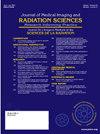Attitudes and awareness regarding the European consensus statement on the use of patient contact shielding
IF 1.3
Q3 RADIOLOGY, NUCLEAR MEDICINE & MEDICAL IMAGING
Journal of Medical Imaging and Radiation Sciences
Pub Date : 2025-03-20
DOI:10.1016/j.jmir.2025.101888
引用次数: 0
Abstract
Introduction
Lead contact shielding has been an essential element of patient radiation protection since its introduction in the early 1900s. The European Consensus Statement (ECS) on Patient Contact Shielding argues that diagnostic radiation doses have decreased to negligible levels. Given the potential for lead shielding to be misaligned or displaced, the ECS recommends refraining from its use to prevent the occurrence of repeated radiation exposures. This study aims to describe the awareness of radiographers concerning the European Consensus Statement with emphasis dedicated to shielding outside the FOV or out-of-field shielding (OFS).
Methods
An online survey was designed to assess radiographer's awareness and attitudes to the ECS. This survey incorporated quantitative and qualitative elements. The survey was distributed to a target population of registered radiographers.
Results
There were 112 participants who registered as Irish radiographers. Seventy-nine (71 %) participants knew of the European Consensus publication on patient contact shielding. Eighty-one (72.3 %) participants agreed that the risk from ionising radiation in general radiography exams is negligible. Seventy-two (63.4 %) participants felt more training should be provided on OFS. Thirty-two (28.6 %) participants agreed that some patients are more sensitive to ionising radiation, and shielding may be the safest action.
Conclusion
The results of this study indicate that responding radiographers are aware of the European Consensus Statement and largely agree with its recommendations to discontinue the use of shielding during low-dose X-ray examinations. Additionally, the study reveals that most radiographers do not employ lead shielding in various common clinical practice scenarios.
Implications for practice
Further investigation is required to evaluate radiographer's attitudes toward contact shielding. Future research might explore the psychological impact on patients, infection concerns, departmental protocols, and discomfort related to contact shielding.
关于使用患者接触屏蔽的欧洲共识声明的态度和认识。
导言:自20世纪初引入铅接触屏蔽以来,铅接触屏蔽一直是患者辐射防护的重要组成部分。关于患者接触屏蔽的欧洲共识声明(ECS)认为,诊断性辐射剂量已降至可忽略不计的水平。鉴于铅屏蔽可能会错位或移位,ECS建议避免使用铅屏蔽,以防止重复辐射暴露的发生。本研究旨在描述放射技师对欧洲共识声明的认识,重点是视场外屏蔽或场外屏蔽(OFS)。方法:设计一项在线调查,评估放射技师对ECS的认识和态度。这项调查结合了定量和定性的因素。是次统计调查的对象是注册放射技师。结果:有112名参与者注册为爱尔兰放射技师。79名(71% %)参与者知道关于患者接触屏蔽的欧洲共识出版物。81名(72.3 %)参与者认为普通放射检查中电离辐射的风险可以忽略不计。72名(63.4 %)参与者认为应该提供更多关于OFS的培训。32位(28.6 %)参与者同意一些患者对电离辐射更敏感,屏蔽可能是最安全的措施。结论:本研究结果表明,响应的放射技师了解欧洲共识声明,并在很大程度上同意其建议,即在低剂量x射线检查中停止使用屏蔽物。此外,研究表明,大多数放射技师在各种常见的临床实践场景中不使用铅屏蔽。实践意义:需要进一步调查评估放射技师对接触屏蔽的态度。未来的研究可能会探讨接触屏蔽对患者的心理影响、感染问题、部门协议以及与接触屏蔽相关的不适。
本文章由计算机程序翻译,如有差异,请以英文原文为准。
求助全文
约1分钟内获得全文
求助全文
来源期刊

Journal of Medical Imaging and Radiation Sciences
RADIOLOGY, NUCLEAR MEDICINE & MEDICAL IMAGING-
CiteScore
2.30
自引率
11.10%
发文量
231
审稿时长
53 days
期刊介绍:
Journal of Medical Imaging and Radiation Sciences is the official peer-reviewed journal of the Canadian Association of Medical Radiation Technologists. This journal is published four times a year and is circulated to approximately 11,000 medical radiation technologists, libraries and radiology departments throughout Canada, the United States and overseas. The Journal publishes articles on recent research, new technology and techniques, professional practices, technologists viewpoints as well as relevant book reviews.
 求助内容:
求助内容: 应助结果提醒方式:
应助结果提醒方式:


